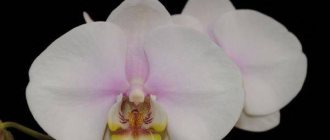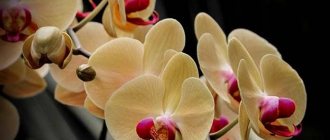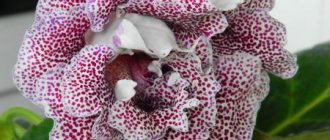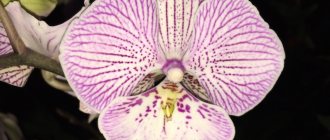Description and popular types
There is no consensus on how the black orchid appeared, both among researchers and flower growers. Some, for example, believe that the flower was stolen by George Cranleith from a South African tribe.
Others believe that the culture was artificially created by crossing several types of phalaenopsis. This process is quite expensive and lengthy, which can explain the scarcity of the flower. In addition, the hybrid phalaenopsis orchid has a rich vanilla aroma, which is its specific characteristic. Only such a plant can rightfully be called “black”. And the black flowers obtained after injecting paint into the bud are just a cheap fake.
Most, unfortunately, consider themselves the owners of a black orchid with a large flower, but this is wrong. In most cases, a burgundy or dark purple orchid is mistaken for such a flower.
The ink-colored Takka flower is often referred to as Phalaenopsis, which, however, has nothing to do with this family of plants.
The most common types of black phalaenopsis orchids are:
- Maxillaria schunkeana. The species is quite rare, this orchid is a rich dark color;
- Fredclarkeara After Dark Black Pearl - The plant is covered with dark blue flowers, which are often considered black. Sometimes these flowers are even called “Black Prince”;
- Paphiopedilum Pisgah Midnight. Flowers of this species have dark veins on their petals, reminiscent of tiger stripes. Therefore, the flower is called “tiger” or “tiger”;
- Phalaenopsis Black Butterfly Orchids. The shape of a flower of this species resembles the wingspan, which is why it is often called a “bird” or “butterfly”. Its color is deep burgundy or purple. Occasionally the petals are covered with white spots;
- Paphiopedilum de Nachtwacht - the petals of the flower of this species are burgundy with a black tint;
- Dracula roezlii. This orchid has deep dark, almost black petals, which are dotted with small light spots.
Growing and planting black orchid flowers, varieties: Prince, Birdie, Widow, care
The black orchid is a very rare and exotic flower. It is shrouded in various myths and beliefs. Scientists are still arguing about the origin of the plant. Most of them are sure that the color of the petals is not black, but dark purple.
Characteristic
Biologists do not have a consensus on whether plants with black petals occur in nature. Many are sure that no, and similar orchids were obtained through selection.
The genus Phalaenopsis can surprise with unusual colors
In fact, if you look closely, you will see that Phalaenopsis black is actually dark purple, maroon or dark blue. This type includes different varieties.
Black bird
The plant is not tall, about 40 cm. The flowers themselves are small, up to 4 cm in diameter. The color is rich blueberry, almost black.
Note! Flowering duration is 8 months.
Black Prince
The most beautiful representative. It has the darkest petals, which have a white core. The diameter of the flowers is 7 cm, the length of the peduncle is up to 50 cm. The leaves of this species are almost invisible.
The Phalaenopsis Prince variety will be appreciated by true connoisseurs of orchids. The number of flowers on one stem depends on the care of the plant and the conditions of its maintenance. If they are properly organized, the plant will bloom profusely.
Black Pearl
The leaves of the variety are almost emerald green, and the number of flowers on one stem reaches four. The petals are purple-burgundy.
Black phalaenopsis orchid Black Pearl looks very impressive
Black Widow
The inflorescences are small, they are collected on a peduncle of 3-4 pieces. The petals are a rich dark blue that looks like black.
Landing
Phalaenopsis orchid - home care
The black orchid had a magical effect on many.
For your information! T. Ford was so captivated by the unusual plant that he named a new perfume in its honor. The film of the same name is also popular.
Tom Ford perfume never loses its relevance. Therefore, many people are looking for the plant that inspired him to create a composition. But for an orchid to bloom, special conditions are needed.
Planting is carried out in loose soil. To do this, mix crushed dry bark, coal, sphagnum, and peat. All components are taken in equal parts.
The pot should be 1-2 cm larger than the root system. A container that is too spacious is not needed, otherwise the plant will begin to actively develop green mass.
Watering
Ludisia orchid: main types and home care options
Phalaenopsis orchids need moist soil. Therefore, in summer the pot is watered 2-3 times a week. It is advisable to plant the plant in a transparent container, this will allow you to observe the condition of the roots.
Important! If the roots turn green, this indicates a lack of moisture.
You can use the tray irrigation method. To do this, place the pot in a bowl of warm water and leave for 20 minutes. Afterwards, the orchid is pulled out and excess moisture is allowed to drain.
Reproduction methods
The easiest way to propagate is by dividing the bush. When transplanting, the pseudobulbs are carefully separated and placed in different pots. The black orchid also reproduces by cuttings. To do this, select flower stalks after flowering.
Violet Black Pearl - description of a home flower
They have dormant buds. It is with them that you need to cut off a section of the stem. After which the cuttings are planted in the ground and covered with a glass jar.
Note! Orchids also reproduce by seeds, but this is impossible to do in an apartment.
Feeding
The black orchid is a beautiful flower that immediately attracts attention. In order for it to show all its beauty, fertilizers are needed. To do this, it is better to use formulations that are designed specifically for orchids.
They are applied during the flowering period once every two weeks. During the dormant period, reduce the number of feedings to once a month.
Do not overuse fertilizers, since an excess of minerals is just as dangerous as a deficiency.
Transfer
You can replant the orchid only after flowering has ended. To do this, carefully remove the plant from the pot.
During transplantation, you need to act carefully, as the roots are easily damaged.
The roots are inspected and damaged parts are removed. Afterwards, the orchid is planted in a new pot, which is then placed in a dark place for 3-4 days. This is necessary for the plant to rest and cope with stress.
Note! Orchid flowers have an unusual shape. They are very sensitive to changes in living conditions, so replanting cannot be done during the flowering period. It is only needed once every 2-3 years, since the bark in the ground has a long service life.
Trimming
After flowering, remove dried flower stalks so that the plant does not waste its energy on it. Leaves that have lost their appearance and began to turn yellow must be removed.
Important! All cuts must be treated with an antiseptic or sprinkled with crushed charcoal.
Old orchids can be topped and rooted. This will rejuvenate the plant.
Pests and diseases
Various plants, even with good care, can be affected by parasites. But some pests appear only with improper care. If the level of humidity is insufficient, orchids are affected by spider mites. It can be easily identified by the cobwebs on the leaves.
Thrips can be easily identified by the larvae on the plant.
Sometimes aphids appear on orchids. It can be detected during a routine examination; these are small green insects. To get rid of these pests, use a soap solution. To do this, dissolve 100 g of laundry soap in 1 liter of warm water. The mixture is sprayed onto the plants.
An excess of moisture is dangerous, as is its lack. When overwatered, root rot develops, which can destroy the plant. It can be identified because the roots turn black and gray spots appear on the leaves. For treatment, the plant is replanted, the affected areas are removed and treated with fungicides.
Another sign of waterlogged soil is the appearance of black spots on the foliage. If this symptom occurs, you need to remove the diseased parts of the plant and stop watering for the time being.
Flowering period
During flowering, all plants are very sensitive to the environment. Therefore, during this period it is necessary to organize good care. Descriptions of varieties do not always give a complete picture of the beauty of certain specimens.
The approximate air temperature should be 22 °C and humidity 40%. To do this, the plant is not only watered abundantly, but also sprayed regularly.
Note! There is a little trick: you can place a bowl of water next to the pots. The moisture will evaporate and humidify the air.
The room with orchids is ventilated once a day. A constant supply of oxygen is important to improve flowering.
Orchids need long daylight hours. To do this, they are placed on the windowsill or illuminated with phytolamps. An orchid needs 12 hours of light per day. It can exude an unobtrusive floral aroma.
Black phalaenopsis is rarely found in collections, but such flowers are very unusual and beautiful. Not only Tom Ford was captivated by this plant. Such flowers can become the pearl of anyone’s home composition.
Source: https://greensotka.ru/orhidei/chernaya.html
Variety of varieties
Wild orchids will not be able to adapt to indoor conditions; they will not survive in a confined space. But there are many different varieties of phalaenopsis, bred by breeders specifically for home cultivation.
The variety of colors of the flowers is simply amazing; the rich palette stretches from white and cream to burgundy and black. Phalaenopsis with yellow flowers look especially elegant and refined, but not everything is so simple here.
The flowers can be pale yellow, almost transparent, or they can be an eye-catcher with a rich, sunny color. As a rule, the core of boles will be the brightest.
The following varieties will delight you with yellow shades (photos are posted below this list):
- Wutuvoi Dream,
- Solid Gold,
- Golden Embers 'Yellow Butterflies',
- Bee Sting,
- Fuller's Sunset
- Anthura Gold and Domenica,
- Gold Rush,
- Dragon's Charm,
- Meraldy Breckenbridge.
All these varieties are characterized by a contrasting color of the lip; it can be red, white, purple, spotted, speckled.
Wutuvoi Dream.
Solid Gold.
Golden Embers 'Yellow Butterflies'.
Bee Sting.
Fuller's Sunset.
Anthura Gold.
Gold rush is not entirely yellow, of course, but some yellowness is visible.
Care
Having a tropical origin, this indoor beauty requires increased attention to itself. Caring for a flower is divided into equal segments, such as:
Substrate
For this variety, ordinary garden soil, of course, is not suitable. Important indicators when creating a substrate are considered to be high drainage capacity and good aeration. You can purchase a ready-made mixture at a flower shop. Having experience, you should mix the appropriate components yourself: crushed pine bark, soil, moss, pumice, etc. The ratio of the components should be approximately the same.
Temperature and humidity
Everyone knows about the whimsical nature of orchids.
As for temperature conditions, then, of course, one should take into account the importance of the constant difference between daytime and nighttime indicators. The difference between day and night temperatures should be stable and remain at 5-7 degrees
In general, the temperature range that is well accepted by flowers is 18-22 degrees.
Depending in part on temperature and watering methods, humidity plays an important role in the life of a flower.
In general, black Phalaenopsis like slightly moist soil, but do not overdo it.
Lighting, watering and fertilizing
Direct sunlight is contraindicated for a dark orchid, but diffused light, either morning or sunset, will benefit this variety of orchids.
There are several types of watering suitable for this species. Before you start moistening the flower, you need to conduct an external inspection of the condition of the plant.
The appearance of a flower can tell you whether it needs moisture
It is also important to check the soil moisture level
Methods:
The black orchid can be bathed under low pressure in the shower. This should be done for several minutes until the substrate is completely moistened. Afterwards, you need to allow excess water to drain through the holes in the container and leave the flower alone for 30 minutes. Repeat this procedure once every 2 weeks. In winter, you should stop swimming. Watering with a tray is the least labor-intensive way to care for a black orchid. The size of the pallet is selected according to the size of the flower. Take into account the height of the drainage system in the plant pot. Water is poured into the pan, and the root system of the precious species itself absorbs the required amount of moisture.
Also, this method provides the necessary air humidity around the flower, which is sometimes so important for its growth and good flowering. Immersion. This method is considered one of the best
The entire pot is slowly immersed in a container of water at room temperature. The time it takes to hold it under water varies from 30-50 seconds to half an hour. Then the moisture must be allowed to drain. Do not immerse all flowers in the same water to avoid disease transmission. Surface moistening and watering. This is applying water in a thin stream to the entire surface of the substrate until excess moisture begins to flow out of the holes.
Fertilization processes are activated during the active phase of flower development, which precedes the formation of the peduncle. During the flowering period, feeding should be suspended. During the dormant period, you should also not add additional nutrients to the soil.
Possible problems during cultivation
Caring for a hybrid is very simple. However, sometimes gardeners face the following problems:
- yellowing of leaf blades due to lack of moisture or damage by sucking pests,
- swelling of the leaves due to prolonged contact with water,
- cracking of leaf plates due to excess fertilizer,
- falling off of the vegetative part due to lack of light or decreased air temperature,
- frostbite of the plant in winter when ventilating the room.
To avoid such situations, the following preventive measures are recommended:
- do not allow excess nitrogen in the substrate after fertilizing,
- do not spray phalaenopsis in autumn and winter, when the room temperature is low, there is poor air ventilation,
- prevent the development of diseases by spraying with fungicides,
- do not allow the root system to overheat.
Diseases and pests
The ailments of all epiphytes are the same, and the treatment is practically no different. The main thing is not to let things get to the point of no return, when you can no longer help the plant.
The spider mite manifests itself as a white and weightless web on the leaves and trunk. The bugs themselves are difficult to notice with the naked eye.
Treatment:
- Rinse the orchid under a warm shower.
- It is easy to wipe the green plates with a damp sponge.
- Spray with acaricide according to the instructions on the package. For epiphytes, the drug Fitoverm is best suited.
- Depending on the complexity of a particular case, you will need from 2 to 4 treatments once a week.
Rot and gray mold appear as a sudden stop in development and dark spots. Only the second one is also shown on the petals, as small black dots. The buds disappear after this. The disease occurs due to waterlogging of the environment at low air temperatures.
Treatment:
- A complete replantation into a new substrate and pot with cleaning of the rhizome and aerial parts from the affected areas is required. All cuts are sprinkled with cinnamon or crushed coal.
- Stop watering and place the plant in a brighter and warmer place. With the latter, the main thing is not to overdo it, otherwise you will only make things worse.
- Treat Kaoda with “Fundazol”, following the recommendations from the manufacturer during the process.
Does a flower exist in nature?
According to biologists, the color black does not exist in nature in the form in which it is familiar to humans. The shade closest to black is provided by special pigments, which can be violet, dark purple, or blue. Therefore, phalaenopsis supposedly black in color is in fact usually dark burgundy, dark purple and even dark blue. Visually, such a plant looks black, but the difference can only be noticed upon closer examination of its petals. Since initially the difference from black in such shades is not very noticeable, the black orchid received this name.
Varieties of dark phalaenopsis
Science knows several varieties of orchids that differ from their counterparts in the very dark color of their petals. Of course, they stand out among all varieties of phalaenopsis:
- Maxillaria schunkeana. This is a low plant with rather small flowers and is odorless. At first glance at the flowers, you get the feeling that their petals have a rich black color. But upon closer examination, it becomes obvious that the flower is dark burgundy in color. It should be noted that this variety is very rare.
- Fredclarkeara After Dark Black Pearl. The second name of this variety of orchids is “Black Prince”. The flowers of the plant are truly pearls of dark purple or dark blue color, with a bright sweet and at the same time spicy aroma.
- Paphiopedilum Pisgah Midnight. The flowers of the plant are dark purple in color with clear black veins. It is because of them that this species is also called the “Black Tiger” orchid.
- Paphiopedilum de Nachtwacht. The petals of this plant are maroon or dark brown. The orchid is characterized by two large flowers, which are located on a long peduncle.
- Phalaenopsis Black Butterfly Orchids. The flowers of these exotic orchids are maroon or dark purple in color and look very similar to butterfly wings. Therefore, this type of phalaenopsis is called “bird” or “butterfly”. On the edges of the petals and on the lip of the flower you can see white specks, which indicate that the plant is quite comfortable and happy with everything.
- Dracula roezlii. The very dark petals of these flowers are covered with small light spots.
Black orchid - myth or reality?
Rationalists are firmly convinced that the color black does not exist in the plant world at all, since there is no genetic pigmentation that is responsible for the ideal black shade.
Consequently, the existence of a mythical flower is just a fiction, and beautiful pictures with its image are the fruit of computer graphics.
However, romantics insist on the opposite. Moreover, in support of their beliefs they cite the fact of the spread of the black orchid in Europe by a certain George Cranleith. The botanist allegedly, while traveling along the shores of South America at the risk of his life, got hold of a rare plant and told the whole world about it. But there is no documentary evidence of this.
Scientists explain the phenomenon of the flower with rich variations of maroon and dark blue shades. However, if you look closely, they can be found in any black color. So, perhaps, in wild damp forests on the seashores somewhere on the globe the black orchid lives, but breeders have done their bit by delighting ardent flower growers with new hybrids. Californian botanists achieved particular success, who managed not only to develop varieties of black orchid, but also to patent them. Obviously, there is a marvelous flower, and to get it, you don’t need to wander into the dense American jungle, you just need to go to any flower shop.
Optimal conditions of detention
Exotic black phalaenopsis need conditions that are as close as possible to their natural habitat. For normal development and abundant flowering, they need moisture, sun and warmth, that is, conditions similar to a tropical environment.
When growing orchids, it is very important to provide them with the required temperature conditions. The most suitable temperature range is considered to be within 18-22°
Maintaining the temperature at the specified level will stimulate abundant and long-lasting flowering of plants. If the air temperature in the room where the orchids grow is inconsistent, then the phalaenopsis simply will not bloom.
No less important for phalaenopsis is moisture, which must be present both in the substrate and in the air. These tropical flowers do not tolerate moisture deficiency well, during which they begin to form buds less frequently and in smaller quantities. However, excess moisture can be no less harmful for these exotics. An excessively waterlogged substrate can lead to rotting of the roots and, as a result, the death of plants.
Gardeners consider the optimal level of air humidity when growing orchids to be 30-40%. If the air in the room is too dry, the leaves of the plants will begin to wrinkle, losing their juiciness and natural turgor. To prevent this from happening, phalaenopsis should be regularly sprayed with a spray bottle. A wide bowl of water located near the pots will also provide the plants with moisture.
It is important to ensure good ventilation in the room where exotics grow. Oxygen deficiency negatively affects both their condition and the duration of flowering
Regular ventilation will help ensure a flow of fresh air to the plants, during which orchids should be removed from the windowsill, preventing them from being in a draft.
Black orchids are very demanding of sunlight. Insufficient light is one of the common reasons why these exotics do not bloom. If daylight hours are less than 12 hours, then plants simply do not have enough time and energy to form buds and ripen them. To compensate for the lack of light, it is recommended to illuminate orchids with a fluorescent lamp.
However, in an effort to provide orchids with maximum illumination, we should not forget that direct sunlight can negatively affect the condition of delicate flowers and leaves.
Maintenance and care
This is the most important part, since a lot depends on proper care of the plant. It is worth considering what needs to be done so that it feels good and can bloom profusely for a long time.
It is very important to water correctly. The orchid loves moisture, but if there is a large amount of it, the roots quickly begin to rot. Here is the watering algorithm:
- It is necessary to water once every 7-10 days if the plant does not bloom.
- During the flowering period, water every 10-12 days.
- If it is hot outside, watering is done every 2-4 days.
- You can determine whether it is necessary to water by looking at the top layer of soil: if it is dry, then it should be moistened.
- Spraying is required periodically. However, water should not get into the rosettes of the leaves, as this can cause rotting.
Reference. It is impossible for moisture to get into the rosette of the sheet. It must be removed immediately. Otherwise, the flower will begin to rot. You also need to remove all the water that will be in the pan 30 minutes after watering.
There are also temperature requirements. So, the air temperature should not be higher than 27 degrees and lower than 22 degrees. The exception is night. Then a decrease to +18 degrees is allowed. The orchid loves moist air, so many florists install a humidifier in the room where it stands. You can also place a container of water nearby. It will be much cheaper, but the result will be the same. The optimal humidity level is 80% 90%.
It is recommended to introduce fertilizing. Here are some nuances that are worth knowing:
- it is necessary to purchase specialized mineral fertilizers for orchids,
- minerals are diluted according to the instructions, but the dosage is made a little less,
- Next, you need to introduce complementary foods,
- observe the behavior of the plant for 2-3 days,
- Continue complementary feeding according to instructions.
These are the basic rules for caring for a flower. After flowering, you need to remove dried buds, as pathogens can form in them.
Description of black orchid species
Black orchid... What is it about it that could win the hearts of millions and set it apart from all the diversity of orchids in the world? After all, each variety has something to surprise admirers of floral beauty.
The mysterious flower attracts with its delicate vanilla aroma. Black orchid flowers, playing with different highlights, enchant with their sophistication. Each variety has something unique.
Nowadays, scientists are proud of dozens of new names. Let's look at the features of the most beautiful and sought-after ones.
Maxillaria schunkeana
This rare species exists in all its pristine nature in the wild. Its specimens were found in the Brazilian Espirito Santo on the Atlantic coast of the tropical forest at an altitude of 700 - 3500 m above sea level.
Characteristic features are short stature, small flowers and lack of odor. The stems and foliage grow to a maximum of 25 - 30 cm, and the flowers reach a diameter of about 1.5 - 2 cm. The color of a dark orchid in poor lighting really appears black, but if you look closely, a dark purple tint is noticeable. By the way, among all types of black orchids, this shade is the most saturated. It has four petals, opening to resemble the shape of a tulip. The inflorescences are located in the basal part. Since the length of the peduncle is about 3 - 5 cm, it seems that the maxillaria appear directly from the bulbs.
In indoor conditions, the plant prefers warm, moderately humid air. The root part requires careful treatment, since any unprofessional intervention threatens damage to the kidneys and their deterioration. Also, the flower will not forgive you for swampy slurry in the pot. It is recommended to plant such unique plants in small bowls.
Fredclarkeara After Dark Black Pearl
The species is the result of a complex interspecific hybridization of Catasetum, Mormodes and Clovesia. A mature orchid produces four peduncles, each with 10 to 15 flowers up to 5 cm in diameter. Black flowers with a sweet spicy aroma resemble the shape of tulips; a brush forms on the peduncle. The leaves are succulent, bright green, and die off in the winter.
After hibernation, the roots, together with the stem, produce a kind of pseudobulb, which is a thickened sprout. It contains concentrated reserves of useful substances. When the green biomass finishes growing, inflorescences form. As a rule, this period falls on October - November. The juiciness of the petals lasts up to 8 weeks. A typical feature of the variety is the periodicity of flowering. When caring, it prefers moderately warm temperatures and bright lighting. Cultivated at home without problems
It is important not to overdo it with watering and fertilizing during the period of shedding leaves. It is better not to disturb the plant at this time.
Paphiopedilum Pisgah Midnight
Of all the types of black orchids, these are distinguished by the darkest dense tones. The blooming inflorescences are monochromatic, often dark purple, with clear black veins visible on the petals. When exposed to sunlight, a pleasant burgundy tint appears on them. The shape of the flowers resembles a shoe made up of three petals. The throat is crimson with a smooth transition to scarlet, the middle is yellow. In care, the flower is no different from other paphiopedilums. The plant needs a substrate made of tree bark and a transparent container, frequent air humidification, timely watering and fertilizing.
Paphiopedilum de Nachtwacht
A dark burgundy orchid shimmers with a brown tint in the sunlight. On a long peduncle, no more than two large shoe-shaped flowers appear simultaneously. The leaves are small, elongated, bright, contrasting against the background of the dark peduncle. For the flowerpot to fully develop, the room temperature should be between 18-22 degrees. Like all paphiopedilums, this variety requires loose, well-drained soil.
Phalaenopsis Black Butterfly
The black orchid from the genus Phalaenopsis received the name of the variety due to its dark petals that resemble wings
butterflies. The magnificent flowering clusters have a rich wine hue. The delicate white specks on the lip add sophistication to the flower. Under favorable conditions, small specks appear on the edges of the petals. The leaves are oblong, succulent, dark green. The peduncle is long. It is characteristic that all the lower flowers are dark, condensed shades, and the higher they are located, the lighter their petals.
Kaoda orchid varieties
Phal kaoda varieties are similar in flower structure, petal color, and leaves.
Chocolate Drops
This plant has earned its extraordinary popularity among orchid breeders due to its unique smell and original colors. The aroma is pronounced, the fragrance is felt throughout the day, while the dark purple bud with a light border is open. The lip stands out against the background of the sepals in white. The green plates are strong and elastic, but grow no longer than 15 cm.
Black Butterfly
A standard with petals resembling the wings of a moth (cherry color). It is distinguished by a large number of buds on one arrow. The delicate white specks on the original lip give the plant a special sophistication.
Twinkle
A hybrid created on the basis of Phalaenopsis Kaoda with bright burgundy fleshy petals. The stem of the plant reaches a length of 19 cm-25 cm, leaf blades - 21 cm-28 cm. An abundantly flowering hybrid that smells only at high humidity.
Black Prince
The amazing darkness of the color is diluted by a barely noticeable white border. The non-standard shaped lip looks like an open pharynx with yellow streaks and spots to match the sepals. This standard is distinguished by its high growth - up to 55 cm, and the diameter of the open buds ranges from 4 to 5 cm. The number of ovaries directly depends on the conditions of detention.
Watering
Watering is probably one of the most delicate aspects of orchid care. The water should be soft enough to almost completely eliminate tap water, which usually contains diluted salts. They concentrate in the substrate and roots of plants, disrupting their growth and flowering.
Watering the plant
Any description of the watering procedure says that it is advisable to use rainwater. But this is quite difficult, because few people will be able to collect and store water every time it rains.
As a substitute, you can use bottled water with a low content of mineral salts, sodium, and calcium. Orchids usually do not need much water to bloom.
Water should only be applied when the surface of the soil is almost dry. Therefore, you should do this about twice a week in spring and summer, during the hottest months; and once every two weeks in winter and autumn. During the period from March to October, it is advisable to add a small amount of special fertilizers to the water.
To water properly, follow these instructions:
- Orchids prefer a moderately moist substrate because if it is too wet, the roots cannot breathe and will rot.
- It is best to leave the substrate dry, watering it a day later. Therefore, the frequency of watering will depend on the ambient temperature.
- You can tell if the plant needs water if the substrate is dry to the touch or if the roots are whitish. If they are green, then no watering is needed.
- Watering should be plentiful, but without flooding the roots.
- The water should be at room temperature.
You should try not to wet the flowers to avoid stains. It is also necessary to avoid getting water on the surface of the leaves.
Attention! The orchid needs high humidity levels, ranging from 60 to 80%
Varieties of “black” phalaenopsis
Black butterfly
On the long peduncle of Phalaenopsis Butterfly there are clusters of medium-sized flowers of a thick wine shade with small light speckles, their petals resemble the wings of a fluttering butterfly, which gives the plant an airy, light exotic look.
Dtps. Black Butterfly.
Black Swan
This orchid is distinguished by narrow fluttering flowers of a deep, almost black color. It does not have any special care requirements other than those required by all representatives of this species. It was described above in the text at the very beginning of the article.
Doritaenopsis Ever Spring Prince "Black Swan" - Black Swan.
Black Pearl
The black pearl is the result of the painstaking work of breeders, thanks to which we can enjoy the sight of this amazing flower. During the flowering period, it produces up to four peduncles, each of which produces up to 15 small (5 cm in diameter) tulip-shaped flowers with a subtle spicy aroma.
Against the background of dark green elongated leaves that die off during the dormant period, these delicate, strong, deep purple flowers look very impressive.
Black Pearl.
Black bird
It can reach a height of 26–40 cm, produces one peduncle, on which blueberry-colored, waxy, dense flowers are formed, characterized by a long flowering time.
Black Bird.
Midi Harlequin
Harlequin is distinguished by its unpretentiousness and resilience. These flowers are given an amazing appearance by light spots of various shapes, appearing in a chaotic manner.
Photo of phalaenopsis Harlequin Mini, dark in color.
Mamba
This type of phalaenopsis forms one peduncle, on which there are up to 10 blue-black flowers with a white core.
It can reach 40 cm in height; the rosette of thick, dense dark green leaves emphasizes the beauty and exoticism of this plant.
Black Mambo.
Black trezor
Phalaenopsis with burgundy waxy flowers reaching a diameter of 6 cm has long been the dream of many gardeners. The color of the petals is so thick that visually the flowers appear almost black.
It is unpretentious in care and has the same requirements for growing conditions as other varieties of phalaenopsis.
Phalaenopsis Black Tresor.
Features of phalaenopsis flowering
This crop can bloom for quite a long time. As a rule, this period lasts from 2 to 5 months. When conditions are ideal, flowers can be enjoyed throughout the year. The break will only be a couple of months.
Here are some features of phalaenopsis flowering:
- buds appear only on the peduncle,
- it is possible to have three peduncles, but often there are only two,
- on one peduncle there are up to 12 flowers of the same size,
- flower size is about 4.5 cm,
- the buds emit a pleasant aroma, but it may be absent in some varieties.
Reference. During flowering, you need to be careful in care. The plant must not be replanted or pruned. However, it is recommended to fertilize in order to get more abundant flowering, which can last. The soil is irrigated so that no water gets on the flowers.
Common diseases and pests of black orchids
How sad it is when a tropical beauty loses its pristine appeal. The leaf blades are the first to suffer. They turn yellow and fade unnaturally.
They appear:
- cracks;
- growths;
- dark spots;
- marble color;
- red dots.
The root system, stems, buds and flowers are often affected.
The causes are the following diseases:
- late blight;
- brown, dry and white rot;
- Phomopsis;
- rust;
- Alternaria blight.
To restore the flower to its former beauty, treatment is carried out. For this purpose, special preparations are used, following the instructions provided.
Unfortunately, the black orchid is affected not only by diseases, but also by pests. They settle on the substrate or the plant itself.
The most common:
- mites;
- thrips;
- moths;
- scale insects;
- aphid;
- slugs;
- midges;
- springtails;
- idiots.
All kinds of insecticides, which are sold in specialized stores, will help get rid of them. Only timely treatment will protect the black orchid from hated pests.
Flower planting technology
Planting an orchid is not difficult. However, it is necessary to choose the right pot and soil. How the flower will feel and whether it will be able to develop normally depends on this. It is better to use a plastic pot. It must be transparent. The root system should also receive sunlight. Despite the fact that many phalaenopsis do not need soil, it is better to use it. This will ensure the plant's stability.
There are certain requirements for the selection of soil. It should consist of:
- large bark,
- sphagnum moss,
- coconut fiber,
- coal
Reference. Some florists themselves make the necessary mixture, however, in this case there is a risk that it contains pest eggs. To avoid this, you should buy soil in specialized stores. It has already been treated against possible pests, and is also enriched with nutrients that are so necessary for the plant at any stage of its life. That is, after planting there will be no need to apply mineral fertilizers.
Here's how to plant a flower:
- First you need to disinfect the pot,
- then put a drainage layer in it,
- then you need to pour the prepared mixture into it,
- plant an orchid,
- You also need to sprinkle the flower with a little earth on top.
Important. Do not apply fertilizer right away. The culture needs to be placed in a dark room for a couple of days so that it can acclimatize. Then it is placed in the place where it will grow. From this moment you can begin to introduce fertilizing.
Features of care
Its unpretentiousness in conditions and care has made the white orchid one of the most popular flowers for home cultivation.
Optimal conditions of detention
The optimal conditions for growing white orchids are:
- diffused light;
- 14 hour daylight hours;
- maintaining the temperature at 22-24°C;
- maintaining humidity (at low humidity, daily irrigation with “rain mist”), avoiding moisture getting into the flower rosette;
- a clear plastic pot with sufficient drainage holes;
- no draft.
Example of a phalaenopsis pot.
Flowering time and dormant period at home
Flower growers should know that predominantly all varieties of white orchids are distinguished by long-lasting flowering. They also have virtually no rest period. Of course, if conditions are created that are acceptable for her and proper care is provided.
The time of year does not affect the flowering time. Typically, white phalaenopsis blooms for about six months and, after a short break, begins to bloom again.
Watering and fertilizing
One of the important stages when growing any type of orchid is proper watering and timely dosed fertilizing.
Watering is carried out in two ways - with a watering can and immersion. During the flowering period, it is best to provide watering with a watering can, then the risk of damage to the buds is reduced.
The substrate is saturated with moisture by carefully watering along the edge of the pot once a week. During the dormant period or before flowers appear, use the immersion method, lowering the pot into a container of water for a couple of minutes.
Important! Water for irrigation should be settled, soft and not cold. The optimal water temperature for irrigation is +28 °C
Frequent watering is excluded.
For full development and flowering, additional feeding is necessary. It is produced several times a month with special complex fertilizers for orchids:
- in the summer and during the flowering period it is carried out 2-3 times a month, preferably with a reduced dosage;
- in the cool season, fertilizing is reduced to 1 time per month.
If there are no buds on the peduncle, then fertilizing is not carried out.
Stimulating flowering
An artificially created slight stress condition stimulates phalaenopsis to flower. To do this, the plant is removed to a room with a temperature of about +18 ° for 8-10 hours, and then returned to its usual place with a warm temperature.
You can also use special preparations that stimulate the orchid to form flower stalks. These include: “Bud”, “Plumen”, “Ovary”, etc.
Pruning after flowering
It is recommended to trim the peduncle of white phalaenopsis in two cases:
- If the peduncle is too long, which spoils its aesthetic appearance for the owner, its arrow is shortened;
- When it turns yellow. If this happens, it is cut off completely.
After purchasing in store
Caring for a flower after purchasing it in a store depends on the condition in which you purchased it:
- How does it stay in the pot?
- Is it sustainable?
- Is it blooming or when has it faded?
- Condition of the substrate, etc.
If the substrate is in good condition and the plants in it are sufficiently stable, then replanting is not required. An exception can be considered replacing a flower pot you don’t like.
For acclimatization, it is better to remove the flower for a while in a shaded and well-ventilated place. Usually 3-5 days are enough for the plant to acclimatize to new conditions.
It is worth feeding the orchid with complex fertilizers, reducing the proposed dosage by 2-3 times
Particular attention should be paid to the root system and provide it with proper watering: spilling - drying
Fertilizing with complex fertilizer.
Attention! In case of a forced transplant, you should purchase a new substrate and create all the necessary conditions.
Prevention of diseases and pests
Experienced orchidists recommend that after purchasing a flower in a store, treat it with a fungicide to prevent diseases. Also carefully examine the root system and remove diseased parts, disinfect the substrate and pot.
When growing, strictly monitor watering, room humidity, temperature, light, etc., since deviation from the required conditions can lead to flower disease.
For preventive measures, timely, dosed fertilizing has proven itself well. They serve to enhance the plant's immune system.
How to properly care
Competent and timely care of the orchid is the key to its stable development and regular flowering. Improper watering, for example, can result in rotting of the trunk or roots, and dry air can lead to an invasion of parasites.
Lighting
It is best if the pot is on the west or east side of the room. To prevent ultraviolet burns from appearing on the foliage, cover the windows with loose curtains or blinds. To ensure that the trunk grows symmetrically, without reaching for the sun, rotate the pot occasionally.
In the summer months, the best source of lighting for Kaoda will not be the hot morning rays, but the muted light of the setting sun. Placing phalaenopsis on southern windows is allowed only if the glass is completely shaded. In winter, plants can also be placed on the south side of the room. It is worth remembering that in short-day conditions, the crop will need to be illuminated with fluorescent lamps so that the illumination per day is at least 13 hours.
The height between the fluorescent lamp and the trunk with additional lighting should be at least 25 cm. If the lamp is installed very close, the plant will receive thermal burns.
Temperature
To provide good conditions for the growth, development and lush flowering of the “dark beauty”, you need to adhere to a temperature range of +17 to +26 degrees. The plant can tolerate heat and low temperatures for several days. However, you should not take risks, since deviations from normal temperatures for five to six days will lead to the death of the flower.
Do not try to warm the orchid using heating devices. Thus, the air around and the plant itself will simply begin to dry out.
Humidity
Since the homeland of this plant is tropical forests, the air around the flower should be well humidified. This can be done by simply spraying both Kaoda itself and the space around it. But when spraying the plant, it is important to ensure that drops of water do not fall on the buds and leaf rosette.
Another way to provide moist air is to place a container of water near the flower.
Watering
Watering directly depends on how the orchid is kept and the season. When planting Kaoda on a block, you need to water it every day, especially on hot summer days. If the orchid grows in a pot or basket, it needs to be watered once every 5 to 7 days. This variety is very resistant to drying and can remain unwatered for a long time.
During watering, carefully protect the rosettes and leaf axils so that water does not get there. Stagnation of water in these places can lead to rotting and further death. Immediately after watering, you can place the orchid under a fan, then all excess moisture will evaporate and will not cause harm.
- In spring and hot summer. Once a week, spill the soil with warm water on top of the pot, preventing water from accumulating. Soaking in water is not recommended. It is best to water in the morning. It is necessary to water only when all the roots have become a uniform silver-gray color.
- In autumn and winter. More rare and careful watering, approximately once every 10-14 days.
Feeding
It is recommended to add additional nutrition twice a month, but this is allowed only during the period of active growth of the orchid. During flowering, Kaoda does not need feeding ─ such manipulation can lead to buds falling off and shortening the flowering period. Fertilizer application is combined with watering to prevent root burns.
In rooms with high humidity and lighting for at least 20 hours a day, the hybrid is fed every week, reducing the dosage by half. Hybrids with this feeding method produce a large number of flowers, up to 70 pieces per stem.
The aerial roots of the hybrid directed in different directions indicate that the plant is overfed and there is a large amount of salts in the soil mixture. To wash out impurities, immerse the pots for half an hour in containers with non-chlorinated water.
Transfer
The orchid is replanted when the substrate begins to decompose. Pine bark expires after 30 months. In addition, transplantation is used:
- if the plant is cramped in the pot,
- The orchid is sick and needs root cleaning.
When performing a transplant:
- carefully remove the plant from the pot,
- in order not to injure the roots, the flowerpot can be cut with a hot knife,
- after removing the flower, rinse the roots under running water, cut off rotten and dried parts,
- Sprinkle the cut areas with powdered activated carbon,
- cut off yellowed and dried areas of leaf blades,
- After pruning, place the plant on a clean cloth to dry,
- fill the container in which the orchid will grow with the prepared soil mixture, plant the flower,
- After planting, water the plant and leave it for ten days in a semi-dark place for better survival.
Preparing the soil and pot
The container must be transparent to allow the root system to participate in the process of photosynthesis. It is recommended to purchase flowerpots with smooth walls, since otherwise the roots will grow into the surface of the pot.
It is better to purchase ready-made soil, designed specifically for the Orchid family. But if the grower wants to prepare the substrate himself, then he will need the following components:
- sphagnum moss,
- bark (preferably pine),
- river sand,
- peat.
All this must be mixed in equal proportions. Don't forget also about the drainage layer, which prevents water stagnation.
The most beautiful and rare varieties
Phalaenopsis never ceases to amaze both with the shape of the flower itself and its color. It is not for nothing that the most beautiful orchids are also the rarest. I would especially like to highlight the following rare colors:
- ghost orchid;
- Lady Slippers with yellow and purple petals;
- Hockstetter variety;
- Phalaenopsis Coleman Coral Root;
- Rothschild's slipper.
- Dragon Mouth;
- sky blue solar orchid;
- Hawaiian swamp;
- Phalaenopsis Bull;
- Three Birds.
All of them are found in the wild, but they grow domesticated very rarely.
Speckled
There are many varieties of spotted-flowered phalaenopsis, all of which are usually developed by crossing two or more species. As a rule, they are ordered from a catalog, but no company can give a 100% guarantee that the standard will bloom exactly like this.
During the flowering period, spots can be scattered chaotically throughout the flower, while all the flowers on the peduncle can be different. But there are standards that retain one specific color from generation to generation.
Fal. Faro.
Ever Spring King.
Kanjer.
Valencia. Where are the spots? Oh, I saw it
Reproduction methods
There are several ways to breed orchids:
- cuttings
- seeds,
- dividing the bush.
It is worth considering each of them in more detail.
Cuttings
This is the most common method. A peduncle is used for this. It is recommended to start the process in the spring. It is worth noting that the new plant will inherit all the qualities of the mother orchid. However, not all cuttings grow roots; some die. You will need to take:
- sharp knife,
- antiseptic,
- Activated carbon,
- plastic transparent container for water,
- plastic bag for the greenhouse.
Here's how the plant reproduces:
- The knife needs to be disinfected.
- Cut off the peduncle closer to the base.
- Divide it into pieces of 10-15 cm. In this case, each cutting should have 2 or 3 buds.
- All sections must be treated with activated carbon.
- Place moss at the bottom of the container and moisten it.
- Place the cutting in the container and cover it to create a greenhouse.
- Moisten the moss periodically and wait for roots to appear.
Important. This method will allow you to get roots with a 60% probability.
Seeds
This is the most difficult method and requires a lot of time from the florist. You need to do everything right. And the flower itself can bloom only 5-8 years after planting. Here's how it goes:
- Pollination of a flower.
- Waiting for flowering to complete.
- Obtaining ready-made seeds from a peduncle.
- Preparation of nutrient medium.
- Seed sterilization. If it is not possible to germinate them immediately, then you need to place them in a paper bag and in the refrigerator.
- Planting and waiting for sprouts to appear. This will take about 9 months.
- Sprout until the flower becomes strong enough. This requires about another 3-4 months.
- Transplantation to a permanent place.
Important. This method of orchid propagation is used only by experienced, patient florists for whom orchid breeding is a business.
Dividing the bush
This is probably the easiest way to propagate an orchid, which gives 100% results. You can resort to it during plant transplantation. Here's what you need to do to do this:
- Carefully remove the flower from the pot so as not to damage the root system.
- Use a sharp knife.
- Cut the bush into two parts.
- Treat each of them with activated carbon.
- Plant in previously prepared soil.
Reference. You cannot get flowers for 1-2 years. The orchid will recover. The culture is delicate, so it takes a lot of time to recover. It is very important to water it correctly and fertilize it.
Reality or myth: a flower shrouded in mystery
The global scientific community still cannot give a definite answer as to where this miracle of nature came from. There is a claim that the black orchid was discovered by George Cranleith (a naturalist botanist) on the South American continent. He stole the flower from local tribes, where the black orchid was considered a sacred untouchable plant. Having discovered that their totem was missing, the natives caught the thief and subjected him to terrible torture. Despite the fact that the scientist’s act was reckless, it was thanks to him, many believe, that humanity learned about a magnificent mysterious plant - the black orchid.
More pragmatic people are confident that the above story is a myth and in fact the black flower was bred by Californian scientists by selecting some varieties of phalaenopsis. Creating such a hybrid is a very complex process that requires significant financial investments. The main feature of the hybrid orchid is its aroma; it is rich in a hint of vanilla. Only hybrid phalaenopsis can be called a black orchid. Some gardeners use chemicals to color the inflorescence. To do this, a corner with a coloring agent is made into the peduncle of a white orchid, due to which the shade of the flower itself changes, as can be seen in the photo.
Scientists are sure that there are no black flowers in nature itself; such a pigment does not exist in principle. These are just very dark shades of violet, purple or burgundy.











